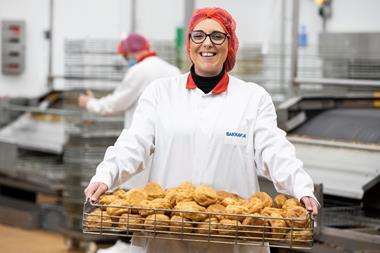Will the issue of fat as an ingredient become even more regulated at UK government and EU levels. And if so, what can bakers do? Our latest BB Round Table debates the issues involved. Andrew Williams reports.
In 2009, BB held a debate with the Food Standards Agency (FSA) over its proposed saturated fat reduction targets for foods. Eighteen months and a change of government later, with the FSA’s nutrition regulation role switching to the Department of Health (DoH), this sleeper issue is set to be awoken later this year as part of the DoH’s Responsibility Deals.
The government guideline for saturated fatty acids is that intake should account for no more than 11% of food energy intake. While three-quarters of respondents (73%) to a new Defra survey considered a healthy balanced diet to be important, this did not translate into reduced saturated fat (sat fat) intake. This so-called group of healthy eaters exceeded the government recommendation on sat fats by a third. On average, the percentage of food energy people drew from saturated fatty acids was 14.8%, with little difference between consumers who cared and those who didn’t. In fact, the data showed that 95% of respondents obtained between 10 and 20% of food energy from sat fats.
"We are still eating too much salt, saturated fatty acids and sugar, and not enough fruit and vegetables," stated Defra this month. In light of this, we gathered an industry group of bakers, retailers, associations and technologists at Leatherhead Food Research to ask, ’Have the challenges changed?’
Geoff Talbot: In 2010, a paper came out summarising recent papers and found that there’s no significant evidence for concluding that dietary saturated fat is associated with an increased risk of coronary heart disease (CHD). So you start to think ’OK, what’s all the fuss about?’ [The government] is also saying that if you replace saturated fat with polyunsaturated fat, then this will reduce the risk of CHD. Replacing saturated fat by polyunsaturated fat is far more beneficial for CHD risk than is exchanging saturates for carbohydrates. So if you’re going to take saturates out, these people are saying replace them with polyunsaturates, not with carbohydrates. Now that’s easier said than done, because clearly polyunsaturates have a different functionality, a different effect on texture and so on.
Wayne Morley: There’s a need to compensate the loss of structure and my belief about fat reduction is that you can always reduce fat a little bit what we call ’salami slicing’ where you take a little bit off the product quality and the consumers don’t notice. But if you do that 10 times, the consumers might notice, so eventually, you’ll get caught out and there may be a long-term detrimental effect on your product. There’s also a cost reduction that you can gain, but then you have to be wary of quality deterioration particularly in oxidation.
Geoff Talbot: How difficult is it to reduce saturated fats without compromising the quality of your products? Maurice, you were saying you use a lot of clotted cream and things like that and I guess there’s not much you can do with products such as those.
Maurice Matthews: Yes, it’s quite difficult. Often, retailers are looking at percentages on back of pack and want to be one up on their neighbours. So you end up having very highly enriched products that don’t necessarily deliver an awful lot more to the consumer if they were eating blind. It’s this perception thing ’we want it to be as high in butter, as high in clotted cream as possible’.
Claire Morgan: So you’ve got two drivers driving you in two different directions one for quality and one for perceived health, so there’s no joined-up thinking. [You’re] forced to look at portion size, a smaller scone or a smaller deposit of cream or more jam and less cream, for example.
Maurice Matthews: One of the main obstacles for us is that you can make reductions, but not at a level where you can make any [on-pack] claims so what’s the driver? It’s quite a substantial reduction you need to make it would totally undermine the quality and it becomes unreachable.
Geoff Talbot: All of the FSA’s targets are well below the level you can claim. I mean, you can claim 30% reduction, but [the government] is talking about 5% and 10% reductions.
Supermarket technologist: The only place you could actually do it is on patisserie counters, because you don’t want to give as much information to the customer. That’s the area I’ve looked at first, because you can take out saturated fat content, salt content, slowly. But as soon as you put it on a pack and say there’s a 30% reduction my view is that customers won’t buy it.
Tom Van Ek: But if you see that there’s a desired decrease of saturated fat, why do you specifically need to reduce it to a claimable level? Is it not possible just to reduce it and make more healthy products?
Richard Lee: It seems to me that the salami approach is favoured, because the claims are so difficult to achieve. I think perhaps biscuits [where manufacturers like United Biscuits have prominently claimed 50% sat fat reductions on pack] occupy a more central component of people’s dietary habits than a muffin. The muffin is seen as the more indulgent product whereas the biscuit is more of an everyday product. People are more ready to accept a reduction because they understand that they eat a lot of biscuits and so it’s going to be good for their health.
Geoff Talbot: Should we make a distinction between reduced fat and reduced saturated fat? Because reduced fat can have a lot more critical effects on the product than taking the saturated fat out or reducing the saturated fat but keeping the total fat content the same the effects are going to be different.
Maurice Matthews: That depends on whether you’re sourcing natural fats (butter, clotted cream and cheese) versus manufactured fats.
Richard Tovee: To reduce saturated fat, it depends on the product. In some products, you can reduce the total fat, but you need to keep the saturates where they are slightly higher to retain functionality. If you’re producing an own-label product in multiples, you’re limited to keeping a very clean label, very ’kitchen cupboard’, so you need to take stuff out but you cannot put anything in. There has to be a point where [supermarkets] will accept using new and interesting technology, or we cannot go any further down the road. If you’re making chilled sausage rolls that are sitting in a chiller for 12 days, you’ve got a big issue with keeping shelf-life and end eat quality, so the challenges are very, very different within the industry.
Supermarket technologist: My personal view would be that that is the most sensible way to go just take it down, but not actually jump up and down about it. [The patisserie counter] is a good area to try out, say, carrot cake take the saturated fat content of that down and see what the consumer thinks.
Claire Morgan: What we’ll see more of is products that have different attributes. For example, we have a butter cream cupcake, which obviously has quite high fat content because of the butter cream. Now, we also do a whoopie pie, which has got a smaller deposit of butter cream in the middle. So if you look like-for-like and [the customer] is looking for a lower-fat option, then we’re going to present the whoopie more to our customers, because it’s a nice eat, it’s got good quality attributes and it’s going to hit the fat targets. Another example is muffins: you might not go down the route of reducing the fat of a double chocolate chip muffin, you may present to your customers a morning bran muffin with sultanas and added fruit. So there is a really big call for NPD to go forward in these lower-fat options but not market them as lower fat.
Sylvia Macdonald: Wayne, when people come to you asking for a reduction, who in turn is asking them? Do they say the retailers? Do they say the major foodservice contractors? Who is demanding this reduction ultimately?
Wayne Morley: Good question. Often we don’t know, but I think [bakers] are getting pressure from the retailers. They’re also comparing their own offerings with their competitors, thinking they’re at a disadvantage if their saturated fat levels are higher than the competition. Also, cost is a big driver as well, fat is an expensive ingredient. It’s not acceptable to increase the raw material costs. The business is always looking for a reduction in cost associated with that and it’s often the main driver.
Gary Williams: In our case we’re looking at a 300kg mix of pastry to apply half an hour’s production... and if it’s wrong you need to repeat it, it’s all cost.
Geoff Talbot: As I understand the FSA’s target, they’ve divided the baking industry into certain groups like plain biscuits, biscuits with inclusions, chocolate-coated biscuits, plain cakes, cakes with inclusions etc. They have not distinguished really between different phases of products [such as the filling and pastry in a pie].
Gary Williams: In apple pies, where you would look at reducing the fat because we’ve got a large amount of fruit filling, you’re looking for an even bigger percentage drop in the pastry itself. And when you’ve got all-butter pastries, then it’s almost impossible to take the butter out and replace it with margarine. If you want to increase the filling and reduce the pastry then you put the apple pie out of balance. We need to look at areas where you’ve got natural saturates coming from natural products like butter and cream as being quite difficult to reduce saturated fats compared to things like margarines where you can manipulate the blends and get that reduction.
Anthony Kindred: With the salt reduction strategy, the FSA gave individual products targets. But when they reviewed it at the end, they gave [craft bakers] an average of all products in our shops.
Geoff Talbot: So you could do more than their target for some and less for others?
Anthony Kindred: Yes, and they’d give you an average score for all.
Geoff Talbot: Does it also depend on where you’re starting from what level you’re at now or in 2008, or whatever start point you might want to consider?
Anthony Kindred: Probably. I think most craft bakeries are full of cream, cheese, butter products. We’re all going to be starting from a very high level unless we’ve already started on the fat reduction, which I don’t think craft bakeries are thinking of yet.
Sylvia Macdonald: Would major retailers be prepared to compromise on all-butter products, such as shortbread or croissants?
Supermarket technologist: Not if that’s a selling point, no.
Tom Van Ek: But in an all-butter product, you could replace the butter partly with an alternative ingredient?
Supermarket technologist: Not if you’re replacing it with another fat and you’re calling it an all-butter shortbread.
Tom Van Ek: Something other than fat?
Supermarket technologist: It depends where you’re selling it. If you’re selling it as a pre-packed product, there’s a clear ingredient declaration. If it is a counter product, there are possibilities, but generally we have to stick to cleaner ingredient declaration as much as possible. But there is manoeuvrability. Salt targets are averages across the whole range, so I have got some flexibility there. I have to push some suppliers to go further in order to make other products go in.
Richard Tovee: If everything has to be reduced, but not an all-butter croissant, then it puts that into a league of its own because people know they can still buy a product with all the taste and calories and there’s nothing to stop them from doing that. Should the government be doing more to educate customers on what they eat and when? You might get to the point where the government says you can do an all-butter croissant but you put a tax on it because it’s higher in fat the dreaded action we’ve all heard about.
Karin Visser: There is a saturated fats tax coming up in Denmark, which was supposed to start in July but has been postponed to the autumn. In Brussels now, they’re talking about whether to make the declaration of trans fats obligatory on the label. Now they advise that you should not mention hydrogenation, but how much trans fat is in it. So that gives way to use fully-hydrogenated oils and fats again.
Richard Tovee: I think we’ve shot ourselves in the foot there [by declaring ’no hydrogenated fats’ on products] as the consumer now sees ’hydrogenated’ as killer fat.
Geoff Talbot: Should certain treat products, such as indulgent cakes and butter pastry, be exempt?
Wayne Morley: Maybe the government has to change the definition of an all-butter croissant, so it can contain 80% butter and 20% other fats with looser definitions of certain types of products.
Geoff Talbot: Can you imagine The Daily Mail getting hold of that one?!
Wayne Morley: Exactly.
Adrian Short: Croissants are one of these products that falls into an area where the fat is the function in the food and you really cannot compromise as soon as you start to do so, you cannot put another ingredient in or fat, you need it it’s what the product is.
Geoff Talbot: The dairy industry would claim that the saturates in milk fat are not as unhealthy as saturates in palm oil, for example. Is there also a distinction that we should be making between dairy-based products and vegetable fat-based products?
Karin Visser: There are still investigations going on as to whether the trans or sat fats from dairy products are better than plant fats, but this is still an open issue. We would disagree.
Stephanie Brunyee: With traditional products like shortbread, where butter is a functional ingredient as well as being perceived by the customer as a quality indicator, [the FDF has] always made a point that they need to be taken into account.
Geoff Talbot: Some time ago, I looked through the saturated fat contents of different sectors of bakery products and there’s a huge range you might have, say, an average of 40%, but that could go from 25% up to 55% across cakes, biscuits, bread, doughnuts etc.
Anthony Kindred: Small manufacturers are going to have to rely on their suppliers for help with reformulation. We don’t have any research budgets in our businesses.
Fiona Wright: From the foodservice side, initially there was a lot of pressure put on us to think about [sat fat reduction], but we’ve never actually been forced to do it. When it came down to actually taking the product, [customers] didn’t care what the level was. We found that reducing portion size was the easiest way for us to reduce our fat level, but if we offered a company a 14-portion cake and a 12-portion cake, they went for the 12-portion cake because it gave a better plate average. So they go against what they’re asking for.
Maurice Matthews: The white elephant in the room is fat tax. I had no idea that Denmark was looking at that and if you could just put yourself back 10 years ago to the days before a smoking ban and to think that there would be a ban on smoking in all public places including pubs etc unthinkable. I just wonder if, in 10 years, we’re going to be looking back on an event like today and thinking, ’Wasn’t it inevitable?’
Around the table
Geoff Talbot, ’The Fat Consultant’; Gary Williams, Kensey Foods; Russell King, Cherry Tree Bakery; Gary Gould, Cherry Tree Bakery; Stephanie Brunyee, Food and Drink Federation; Fiona Wright, Aulds; Anthony Kindred, National Association of Master Bakers/Kindred Bakery; Desiree Lend, Bread Roll Company; Richard Tovee, Kerry Foods; Adrian Short, Ulrick & Short; Supermarket bakery technologist (anonymous upon request); Wayne Morley, Leatherhead Food Research; Stuart Clegg, Leatherhead Food Research; Richard Lee, Social scientist, University of Sheffield/Fosters Bakery; Tom Van Ek, Smilde Foods; Karin Visser, Smilde Foods; Maurice Matthews, Rowe’s; Claire Morgan, The Cookie Man; Richard Boulding, Ulrick & Short; Sylvia Macdonald British Baker; Georgi Gyton, British Baker
The British Baker Round Table sponsors
"In the baking industry, there is a challenge to reduce saturated fat in products, but it’s very difficult to keep the same functionality. If you want to make a cake, it’s not too difficult to put more unsaturated fat in, such as margarine, to get the same quality, but if you want to make puff pastry, it needs its functionality, like firmness, so you cannot make a puff pastry from oil. That’s why we introduced Novarin a range of industrial margarines suitable in a wide range of applications, like cakes, cookies, croissants. It’s a modular approach to fat reduction and saturated fat." Karin Visser, Smilde"
Shelf-life is a massive issue. We have to work very hard on extending and keeping shelf-life and, if you reduce the fat, we think it’s a bit short-sighted to not reduce the calories at the same time, because that’s the next stage we see coming: you will have to look at your overall calorie count and that will be the big number people will be watching.
"The biggest issue that manufacturers face is not just redesigning a recipe but making it happen in the factory."
Adrian Short, Ulrick & Short



































No comments yet